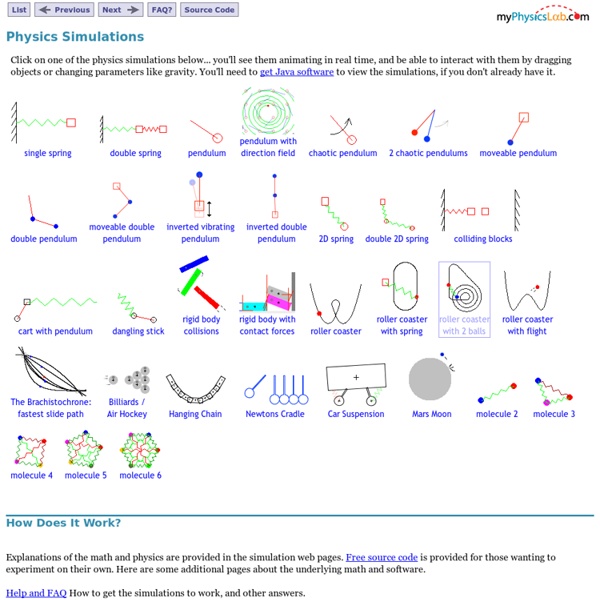



Peanut Software Homepage Page last updated: 13 Sept 12 For automatic notification of updates to these pages, you can subscribe to my RSS feed. My page of FAQ (27 Sept 10) is added to as necessary. Ecosystems for Kids - Science Games and Videos Ecosystems for Kids An ecosystem is a community of living and non-living things that function together. Within an ecosystem, organisms are interdependent and adapted to the environment. Math, Physics, and Engineering Applets Oscillations and Waves Acoustics Signal Processing Electricity and Magnetism: Statics Electrodynamics Quantum Mechanics Lawrence Hall of Science - 24/7 Science Welcome to Twenty Four Seven Science! Activity Collections View All Citizen Science Activities How fast does the wind blow?
Free Online Physics Courses Get free online Physics courses online from the world's leading universities. You can download these audio & video courses straight to your computer or mp3 player. The collection includes introductory physics courses recorded at top universities (e.g. Yale, UC Berkeley & MIT). The Best Edible Science Experiments You'll Actually Want to Eat Hands-on science experiments and projects are always a hit with kids, in the classroom and at home. Want to make them even better? Make them delicious, too! Science Xplained Science Xplained is a collection of video podcasts that tell the stories of the science behind everyday topics. Dr. Ainissa G. Optics: Light, Color, and Their Uses Educator Guide Product Type: Educator GuideAudience: Educators, Informal EducationGrade Levels: K-12Publication Year: 2000Product Number: EG-2000-10-64-MSFCSubjects: Physical Science The guide contains color and light activities using lenses, prisms and mirrors to create telescopes, periscopes, microscopes and kaleidoscopes. Other activities include finding focal length and understanding reflection, refraction and diffraction.
HyperPhysics Concepts About HyperPhysics Rationale for Development HyperPhysics is an exploration environment for concepts in physics which employs concept maps and other linking strategies to facilitate smooth navigation. For the most part, it is laid out in small segments or "cards", true to its original development in HyperCard. The entire environment is interconnected with thousands of links, reminiscent of a neural network.
Evolution of the Universe - GigaPan Time Machine Jump to: From GigaPan Time Machine Direct Cosmological Simulations of the Growth of Black Holes and Galaxies This timelapse shows the distribution of matter in a simulated universe on large scales. The computer simulation was carried out using the cosmological hydrodynamic simulation code P-Gadget on facilities provided by the Moore Foundation in the McWilliams Center for Cosmology at Carnegie Mellon University. Simulation and visualization by Yu Feng (CMU), Tiziana Di Matteo (CMU), Rupert Croft (CMU), Volker Springel (Heidelberg Institute for Theoretical Studies), Nishikanta Khandai (CMU), Anirban Jana (Pittsburgh SuperComputing Center), Jeff Gardner (University of Washington).
Clearest Way to Teach Moon Phases...EVER! I originally found an idea similar to this online and I knew that I had to immediately make a run to the Dollar Tree and rummage through our science storeroom to collect the needed supplies to make this. Essentially, this Moon Phase board allows students to visualize and better understand the cause of moon phases and comprehend the 2 different views that are often given on a diagram (view from space and view from the Earth). Up to this point, I've done a Lunar Lollipop Investigation, which I thought was great, but this beats it by a long shot! A large majority of my students don't really understand why the lit part of the moon doesn't face the sun on part of the view as seen from Earth on every moon phase diagram (see below). What causes lift? Yesterday, I wrote about one of my favorite kinds of clouds: Kelvin-Helmholtz clouds, also called fluctus clouds. You can call them wave clouds, because that’s what they look like: Waves breaking over a beach. I also embedded a video from Sixty Symbols explaining them, but during that explanation the scientist, Mike Merrifield, made a bit of a flub: He said that with an airplane wing, lift is generated because air is moving faster over the top of the wing than the bottom. This lowers the pressure over the wing, so the force under the wing is higher. That pushes the plane up.
Water Cycle in a Bag Activity for ages 3 to 7. I’m always on the lookout for simple, fun kids’ science activities so when I ran across this water cycle in a bag I couldn’t wait to give it a try. It was a quick prep activity that had a big payoff – my boys watched the water do its thing for days. I hope you love this water cycle in a bag too. P.S.